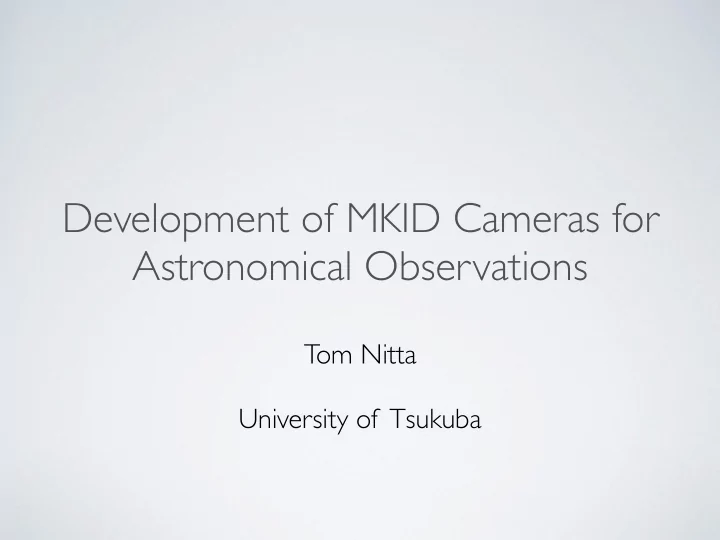

Development of MKID Cameras for Astronomical Observations Tom Nitta University of Tsukuba
Outline ✴ Scientific Motivation ✴ Microwave Kinetic Inductance Detector (MKID) ✴ Development of MKID Camera for Millimeter-wave band ✴ Future Development ✴ Summary
ミリ波サブミリ波の観測に基づく銀河の形成と進化の探求 他大学連合がチリ大学の協力の下で開発・設置した口径 素子 帯カメラ)などによる観測なども始まったが、装置性能の 制約から、深さは 帯で 程度、 領域あたりの広さは、数 平方分から数 平方分 程度に、また、検出されるサブミリ波銀河の個数も、 領域あたり数 個にとどまっており、統計的 な解析を進める上での障害となっていた。 しかし、ここ数年、その次の世代のサブミリ波望遠鏡やカメラが稼働を開始し、サブミリ波帯での 掃天観測が劇的に進展しつつある。その中でも、南米アタカマ砂漠 図 に国立天文台・東京大学 のサブミリ波望遠鏡 鏡搭載 図 )に、マサチューセッツ大学他が開発した 画素 帯カメラ ( )を搭載して、足かけ 年にわたって集中的に実施されたサーベイにより、 帯で ( 帯での深さに換算すれば 程度)というような、過去のサーベイと同等 = 3 = 5 カメラ( ( により始まり、その後、 ) サブミリ波を使った高赤方偏移銀河の研究は、 遠赤外線光度 のサブミリ波銀河を、色々な赤方偏移に置いたときに観測 されるスペクトルを図示したもの。 は、 による平均的なサブミリ波銀 河のスペクトルを使っている。可視光や赤外線、また、波長の長い電波領域では、赤方偏移の増大と 共に、観測されるフラックスは急激に低下するが、波長 付近(赤い帯で示した付近)では、観測 されるフラックスは、ほとんど低下しないことがわかる。 わかる。 これを、別の形で表現したのが、図 である( リ波サブミリ波帯で観測していると、天体のフラックスは、赤方偏移によらずほぼ一定となる様子が 。可視赤外線域や、波長の長い で観測すれば、高い赤方偏移の銀河まで、効率よく観測できるということになる。 周波数 帯の電波)では、赤方偏移とともに、天体のフラックスが急速に 低下する( 補正) 。しかし、波長が 付近から 程度の範囲では、観測されるフラッ クスが、幅広い赤方偏移レンジで、ほぼ一定となっている(負の 補正) 電波(波長 サブミリ波銀河に関する最近の成果 。言いかえればこの波長帯 Survey of Distant Universe ✴ Distant Galaxy Survey - important object for understanding the galaxy evolution - they are expected to be obscured by dust ・ Optical : absorbed by dust ・ mm-wave to THz : dust emission - multi-band observation ・ important for determining the spectrum energy distribution Wang et al., The Astrophysical Journal Kawamura, Master thesis , 690 , 319, 2009 Optical IR THz /mm (Univ, of Tokyo, 2010) IR optical/NIR NIR 1.2 − 2.2 um 3.6 − 8 um 450 − 900 nm 850 GHz 220 GHz redshift (z) = 1 (7.7 billion years ago) 880 um 21 cm IR 24 um Radio Radio z = 3 (340 GHz) ( 1.4 GHz) (11.5 billion years ago) z = 5 (12.5 billion years ago)
Example of Wide-Field Observations * 30 arcmin (0.5 degree) FoV Observation * Multi wavelength observations for determining the redshift. → ~ 100 galaxies were detected � rest (GHz) 10 7 10 6 10 5 10 4 10 3 10 2 10 1 10 2 12 (a) HFLS3 z ~ 6.34 MBB 10 1 14 Arp220 M82 HR10 16 10 0 Eyelash 18 flux (mJy) 10 -1 AB mag 20 10 -2 22 10 -3 24 1’ 26 10 -4 250 µm 350 µm 500 µm 28 10 -5 10 -1 10 0 10 1 10 2 10 3 10 4 10 5 10 6 Casey et al., MNRAS, Riechers et al., Nature, � obs ( ! m) 436 , 1919, 2013 496 , 329, 2013 To observe a lot of distant galaxies, ・ good observation site for millimeter-wave to terahertz astronomy ・ instrument development for wide field-of-view observation are important
Antarctica as a Site for Astronomy ✴ Antarctic Telescope Showa Station − Our group is planning to construct the Dome F two types of telescopes at Dome C & F. Dome A ・ 10 m class telescope @ Dome C (France-Italy site) South Pole ・ 30 m class telescope @ Dome F (Japanese site) Dome C Altitude (m) 0 2000 4000 ✴ Optical depth measurement 0.4 Dome F Ishii et al., Polar Science, 3 , 213, 2010 Yang + 2010 good 200 K, 0.1 mm (25% in winter) ) Dome Fuji Atacama a b (summer) (summer) Dome F Atacama / Mauna Kea 0.3 200 K, 0.14 mm (50% in winter ) ・ Dome F ・ very good site for astronomy Atacama Desert - high transmittance 260 K, 0.6 mm (50% in winter ) 0.2 ・ There are a lot of telescope on these sites Mauna Kea - very stable 270 K, 1.5 mm Antarctica 0.1 (50% in winter ) ・ higher transmittance good ・ THz bands are only available at the Antarctica 0 12/17 23 28 1/3 1/8 14 12/17 23 28 1/3 8 14 Date (2006-2007) Date (2002-2003) mm-wave submm-wave THz
Recommend
More recommend